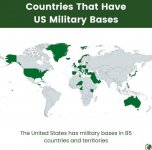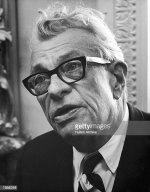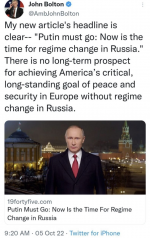You are using an out of date browser. It may not display this or other websites correctly.
You should upgrade or use an alternative browser.
You should upgrade or use an alternative browser.
Welcome to the Precious Metals Bug Forums
Welcome to the PMBug forums - a watering hole for folks interested in gold, silver, precious metals, sound money, investing, market and economic news, central bank monetary policies, politics and more.
Why not register an account and join the discussions? When you register an account and log in, you may enjoy additional benefits including no Google ads, market data/charts, access to trade/barter with the community and much more. Registering an account is free - you have nothing to lose!
Who dun it... Nordstream.

 www.bitchute.com
www.bitchute.com

Reporters Go Into Panic Mode As Based Man Spits Facts Against The Narrative LIVE
My dude brought the facts non-stop. They didn't know what hit them...HAHAHA. SOURCES ➡️https://youtu.be/nbt-CsSRJl8 SUPPORT THE CHANNEL ➡️YouTube Memberships: https://bit.ly/39yRdh8 ➡️PayPal: https://www.paypal.me/Memology101 ➡️Patreon: https://www.patreon.com/AntonioChavez FOLLOW ME ➡️Main...
- Messages
- 18,704
- Reaction score
- 11,217
- Points
- 288
Frontline Tank Battle Avdiivka Russia Ukraine War (Special Report)
With so much news of losses and gains Across the Ukraine - Russia Warzone, it is necessary to look at the real situation at an individual level.
Avdiivka is one of the strongholds of the Ukrainian forces near Donetsk. From Avdiivka Ukraine forces have been shelling Donetsk for over 8 years. Donetsk is the capital of the Donetsk People's Republic, one of the 4 areas that passed Russian-backed referendums to join Russia last week( these include Kherson, Zaporozhya regions and the Lugansk people's Republic).
In this report, I show you what the situation is on the Avdiivka Frontline and you will see the large tank battle that broke out. While there we met many soldiers in Russia but in the "Battalion Angel" .
You may remember the soldier nick name "Angel", we made many interviews with him during the heavy battle of Mariupol, and at our viewer's request soon we will interview him again.
With so much news of losses and gains Across the Ukraine - Russia Warzone, it is necessary to look at the real situation at an individual level.
Avdiivka is one of the strongholds of the Ukrainian forces near Donetsk. From Avdiivka Ukraine forces have been shelling Donetsk for over 8 years. Donetsk is the capital of the Donetsk People's Republic, one of the 4 areas that passed Russian-backed referendums to join Russia last week( these include Kherson, Zaporozhya regions and the Lugansk people's Republic).
In this report, I show you what the situation is on the Avdiivka Frontline and you will see the large tank battle that broke out. While there we met many soldiers in Russia but in the "Battalion Angel" .
You may remember the soldier nick name "Angel", we made many interviews with him during the heavy battle of Mariupol, and at our viewer's request soon we will interview him again.
- Messages
- 18,704
- Reaction score
- 11,217
- Points
- 288
Russia, Ukraine and the "New" New World Order (Canadian Patriot Interview with Vanessa Beeley)
In this Canadian Patriot Review interview with award winning Syrian based journalist Vanessa Beeley, you will learn how to cut through the lies of western corporate media propaganda and come to understand the truth of the recent Donbass elections for east Ukraine to rejoin Russia, why these elections were entirely legitimate, how Ukrainian Nazis are being used as western proxies for geopolitical ends and how this relates to the coming economic meltdown. You will also learn about the infamous kill lists targetting western journalists and influencers challenging the mainstream narrative, the role of Elon Musk within the bigger picture and how all of this fits into the British-controlled White Helmets and the efforts to send Syria back to the stone age.

 rumble.com
rumble.com
In this Canadian Patriot Review interview with award winning Syrian based journalist Vanessa Beeley, you will learn how to cut through the lies of western corporate media propaganda and come to understand the truth of the recent Donbass elections for east Ukraine to rejoin Russia, why these elections were entirely legitimate, how Ukrainian Nazis are being used as western proxies for geopolitical ends and how this relates to the coming economic meltdown. You will also learn about the infamous kill lists targetting western journalists and influencers challenging the mainstream narrative, the role of Elon Musk within the bigger picture and how all of this fits into the British-controlled White Helmets and the efforts to send Syria back to the stone age.

Russia, Ukraine and the "New" New World Order (Canadian Patriot Interview with Vanessa Beeley)
In this Canadian Patriot Review interview with award winning Syrian based journalist Vanessa Beeley, you will learn how to cut through the lies of western corporate media propaganda and come to unders
- Messages
- 18,704
- Reaction score
- 11,217
- Points
- 288
[Forwarded from Vanessa Beeley]
[ Video ]
Here’s some footage Jeremy Bowen brought back from the frontline. The guy’s a bloody hero.

 t.me
t.me
[ Video ]
Here’s some footage Jeremy Bowen brought back from the frontline. The guy’s a bloody hero.

Eva Karene Bartlett
JournaIist. I go to the places I write about (3 years in Gaza; 8 months in West Bank; 1.5 years in Syria; Venezuela; DPRK; 1/2 year in Donbass). https://ingaza.wordpress.com/about-me/
- Messages
- 18,704
- Reaction score
- 11,217
- Points
- 288
[Forwarded from Disclose.tv]
JUST IN - Putin orders per decree the transfer of Ukraine's Zaporizhzhia nuclear plant into Russian federal ownership.
@disclosetv

JUST IN - Putin orders per decree the transfer of Ukraine's Zaporizhzhia nuclear plant into Russian federal ownership.
@disclosetv

- Messages
- 18,704
- Reaction score
- 11,217
- Points
- 288

Figure 1—From the RAND Corporation's 2019 paper on how to destabilise Russia.
This document shows that the US was aiming for a campaign of subversion against Russia, in which Ukraine was only an unfortunate instrument.
Kharkov and Mobilization
October 1, 2022 Jacques Baud
The recapture of the Kharkov region at the beginning of September appears to be a success for Ukrainian forces. Our media exulted and relayed Ukrainian propaganda to give us a picture that is not entirely accurate. A closer look at the operations might have prompted Ukraine to be more cautious.
From a military point of view, this operation is a tactical victory for the Ukrainians and an operational/strategic victory for the Russian coalition.
On the Ukrainian side, Kiev was under pressure to achieve some success on the battlefield. Volodymyr Zelensky was afraid of a fatigue from the West and that its support would stop. This is why the Americans and the British pressed him to carry out offensives in the Kherson sector. These offensives, undertaken in a disorganised manner, with disproportionate casualties and without success, created tensions between Zelensky and his military staff.
For several weeks now, Western experts have been questioning the presence of the Russians in the Kharkov area, as they clearly had no intention to fight in the city. In reality, their presence in this area was only aimed at affixing the Ukrainian troops so that they would not go to the Donbass, which is the real operational objective of the Russians.
In August, indications suggested that the Russians had planned to leave the area well before the start of the Ukrainian offensive. They therefore withdrew in good order, together with some civilians who could have been the subject of retaliation. As evidence of this, the huge ammunition depot at Balaklaya was empty when the Ukrainians found it, demonstrating that the Russians had evacuated all sensitive personnel and equipment in good order several days earlier. The Russians had even left areas that Ukraine had not attacked. Only a few Russian National Guard and Donbass militia troops remained as the Ukrainians entered the area.
At this point, the Ukrainians were busy launching multiple attacks in the Kherson region, which had resulted in repeated setbacks and huge losses for their army since August. When US intelligence detected the Russians’ departure from the Kharkov region, they saw an opportunity for the Ukrainians to achieve an operational success and passed on the information. Ukraine thus abruptly decided to attack the Kharkov area that was already virtually empty of Russian troops.
Apparently, the Russians anticipated the organisation of referenda in Lugansk, Donetsk, Zaporozhe and Kherson oblasts. They realised that the territory of Kharkov was not directly relevant to their objectives, and that they were in the same situation as with Snake Island in June: the energy to defend this territory was greater than its strategic importance.
By withdrawing from Kharkov, the Russian coalition was able to consolidate its defence line behind the Oskoll River and strengthen its presence in the north of the Donbass. It was thus able to make a significant advance in the Bakhmut area, a key point in the Slavyansk-Kramatorsk sector, which is the real operational objective of the Russian coalition.
As there were no longer any troops in Kharkov to “pin down” the Ukrainian army, the Russians had to attack the electrical infrastructure to prevent Ukrainian reinforcements by train to the Donbass.
As a result, today, all Russian coalition forces are located within what may become the new borders of Russia after the referenda in the four southern Ukrainian oblasts.
For the Ukrainians, it is a Pyrrhic victory. They advanced into Kharkov without encountering any resistance and there was hardly any fighting. Instead, the area became a huge “killing zone” (“зона поражения”), where Russian artillery would destroy an estimated number of 4,000-5,000 Ukrainians (about 2 brigades), while the Russian coalition suffered only marginal losses as there was no fighting.
These losses come on top of those from the Kherson offensives. According to Sergei Shoigu, Russian Defence Minister, the Ukrainians lost about 7,000 men in the first three weeks of September. Although these figures cannot be verified, their order of magnitude matches the estimates of some Western experts. In other words, it seems that the Ukrainians have lost about 25% of the 10 brigades that were created and equipped in recent months with Western help. This is a far cry from the million-man army mentioned by the Ukrainian leaders.
From a political point of view, it is a strategic victory for the Ukrainians, and a tactical loss for the Russians. It is the first time that the Ukrainians have taken back so much territory since 2014, and the Russians seem to be losing. The Ukrainians were able to use this opportunity to communicate about their final victory, undoubtedly triggering exaggerated hopes and making them even less willing to engage in negotiation.
This is why Ursula von der Leyen, the President of the European Commission, declared that the moment “is not one for appeasement.” This Pyrrhic victory is therefore a poisoned gift for Ukraine. It has led the West to overestimate the capabilities of the Ukrainian forces and to push them to engage in further offensives, instead of negotiating.
The words “victory” and “defeat” need to be carefully used. Vladimir Putin’s stated objectives of “demilitarisation” and “denazification” are not about gaining territory, but about destroying the threat to the Donbass. In other words, the Ukrainians are fighting for territory, while the Russians seek to destroy capabilities. In a way, by holding on to territory, the Ukrainians are making the Russians’ job easier. You can always regain territory—you cannot regain human lives.
In the belief that they are weakening Russia, our media are promoting the gradual disappearance of Ukrainian society. It seems like a paradox, but this is consistent with the way our leaders view Ukraine. They did not react to the massacres of Russian-speaking Ukrainian civilians in the Donbass between 2014 and 2022, nor do they mention Ukraine’s losses today. In fact, for our media and authorities, Ukrainians are a kind of “Untermenschen” whose life is only meant to satisfy the goals of our politicians.
Between 23 and 27 September, there were four referendums in progress, and the local populations have to answer different questions depending on their region. In the self-proclaimed republics of Donetsk and Lugansk, which are officially independent, the question is whether the population wants to join Russia. In the oblasts of Kherson and Zaporozhe, which are still officially part of Ukraine, the question is whether the population wants to remain within Ukraine, whether they want to be independent, or whether they want to be part of Russia.
However, there are still some unknowns at this stage, such as what will be the borders of the entities that will be attached to Russia. Will they be the borders of the areas occupied by the Russian coalition today or the borders of the Ukrainian regions? If it is the second solution, then we could still have Russian offensives to seize the rest of the regions (oblasts).
It is hard to estimate the outcome of these referenda, although one can assume the Russian-speaking Ukrainians will most probably want to leave Ukraine. Polls, whose reliability cannot be assessed, suggest that 80-90% are in favour of joining Russia. This seems realistic due to several factors.
more:

Kharkov and Mobilization
The recapture of the Kharkov region at the beginning of September appears to be a success for Ukrainian forces. Our media exulted and relayed Ukrainian propaganda to give us a picture that is not entirely accurate. A closer look at the operations might have prompted Ukraine to be more cautious. From
 www.thepostil.com
www.thepostil.com
- Messages
- 18,704
- Reaction score
- 11,217
- Points
- 288
German deindustrialization, transitioning to service based economy

 rumble.com
rumble.com

German deindustrialization, transitioning to service based economy
German deindustrialization, transitioning to service based economy The Duran: Episode 1399
624 Billion More, pretty soon they'll be talkin serious $$.

 www.axios.com
www.axios.com

The Biden administration is sending $625 million in new military aid to Ukraine
"The capabilities we are delivering are carefully calibrated to make the most difference on the battlefield."
- Messages
- 18,704
- Reaction score
- 11,217
- Points
- 288
THE CHURCHILL GANG, FROM STALIN TO FDR TO JFK TO UKRAINE
John Hankey, former H.S. teacher in LA, filmmaker, and historian on The Churchill Gang poisoned FDR, orchestrated the assassination of JFK, and are behind the conflict in Ukraine. Who is the Churchill Gang? Harriman, Prescott & GHW Bush, and the Rothschilds.
The Churchill Gang, From Stalin to FDR to JFK to Ukraine
John Hankey, former H.S. teacher in LA, filmmaker, and historian on The Churchill Gang poisoned FDR, orchestrated the assassination of JFK, and are behind the conflict in Ukraine. Who is the Churchill Gang? Harriman, Prescott & GHW Bush, and the Rot…
Everett Mc Dirkson???
Lancers32
Often Wrong Never In Doubt
- Messages
- 1,842
- Reaction score
- 2,110
- Points
- 298
Famous quote about the govt pissing away money.Everett Mc Dirkson???
Lancers32
Often Wrong Never In Doubt
- Messages
- 1,842
- Reaction score
- 2,110
- Points
- 298
Actually it all adds up.
Lancers32
Often Wrong Never In Doubt
- Messages
- 1,842
- Reaction score
- 2,110
- Points
- 298
USA thinks they rule the world. They need to be careful what they wish for the next guy might not be so patient. Security in Europe?
- Messages
- 35,053
- Reaction score
- 5,963
- Points
- 288

Russian Doomsday Sub Belgorod Spotted in the Arctic - USNI News
A Russian Navy submarine that carries bus-sized nuclear torpedoes was spotted in the Arctic after sparking headlines earlier this week over fears of a nuclear weapons test, according to new photos published on Wednesday. Project 09852 Belgorod was spotted on the surface operating in the Barents...
- Messages
- 18,704
- Reaction score
- 11,217
- Points
- 288
this will redpill everyone who watches it....

 www.bitchute.com
www.bitchute.com
THE CHURCHILL GANG, FROM STALIN TO FDR TO JFK TO UKRAINE
John Hankey, former H.S. teacher in LA, filmmaker, and historian on The Churchill Gang poisoned FDR, orchestrated the assassination of JFK, and are behind the conflict in Ukraine. Who is the Churchill Gang? Harriman, Prescott & GHW Bush, and the Rothschilds.
The Churchill Gang, From Stalin to FDR to JFK to Ukraine
John Hankey, former H.S. teacher in LA, filmmaker, and historian on The Churchill Gang poisoned FDR, orchestrated the assassination of JFK, and are behind the conflict in Ukraine. Who is the Churchill Gang? Harriman, Prescott & GHW Bush, and the Rot…





